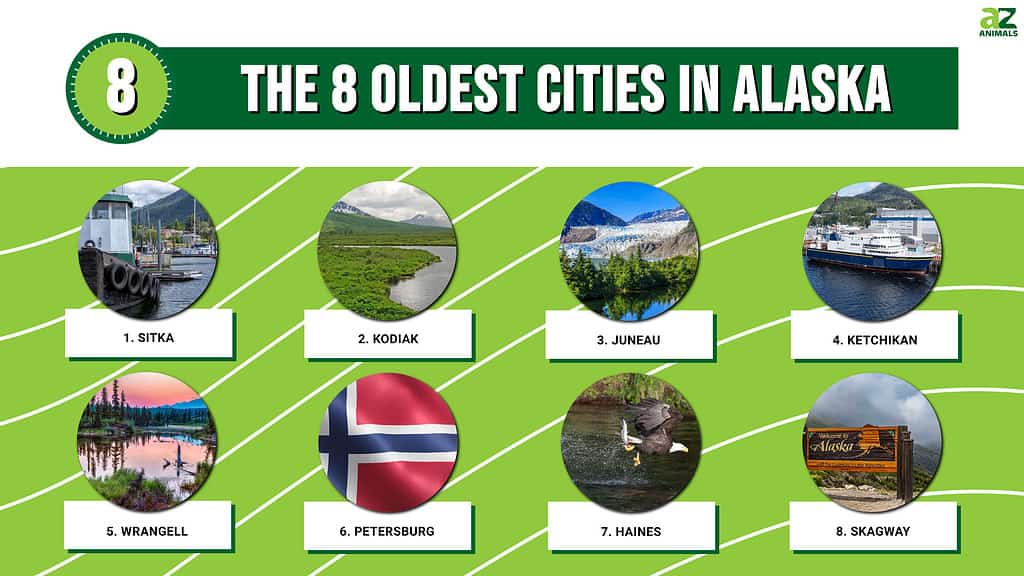
Alaska remains a fascinating gem within North America. Not only is Alaska the largest state in the U.S., but four of the largest cities by area are located here. It abounds with an illustrious history, breathtaking landscapes, and a rich culture bubbling with native heritage. Alaska lies in the country’s far northwest and is the third least populated state.
Alaska has 149 incorporated cities. However, this article will focus on the eight oldest cities in the state. Because of its climatic conditions, most of Alaska is uninhabited. To put this into perspective, 149 cities only cover 2.1% of the total land area, while more than 65% of the population lives within them. For example, Anchorage is the most populous city, with a population of 291,247. Conversely, Kupreanof municipality is home to only 21 residents.
Alaska’s story dates back thousands of years. It was initially inhabited by native tribes, which explains the numerous ancient settlements. Russians inhabited the territory for a brief period before selling it to the United States in 1867. Alaska was an organized incorporated territory of the United States from 1912 until they were granted statehood in 1959.
With numerous documentaries covering the exploits of Alaska, most Americans are fascinated by this state. The most captivating drone shots include mountainsides, whales swimming in icy waters, and dense forests. In this article, we will explore the eight oldest cities in Alaska, delving into their distinct histories.
1. Sitka
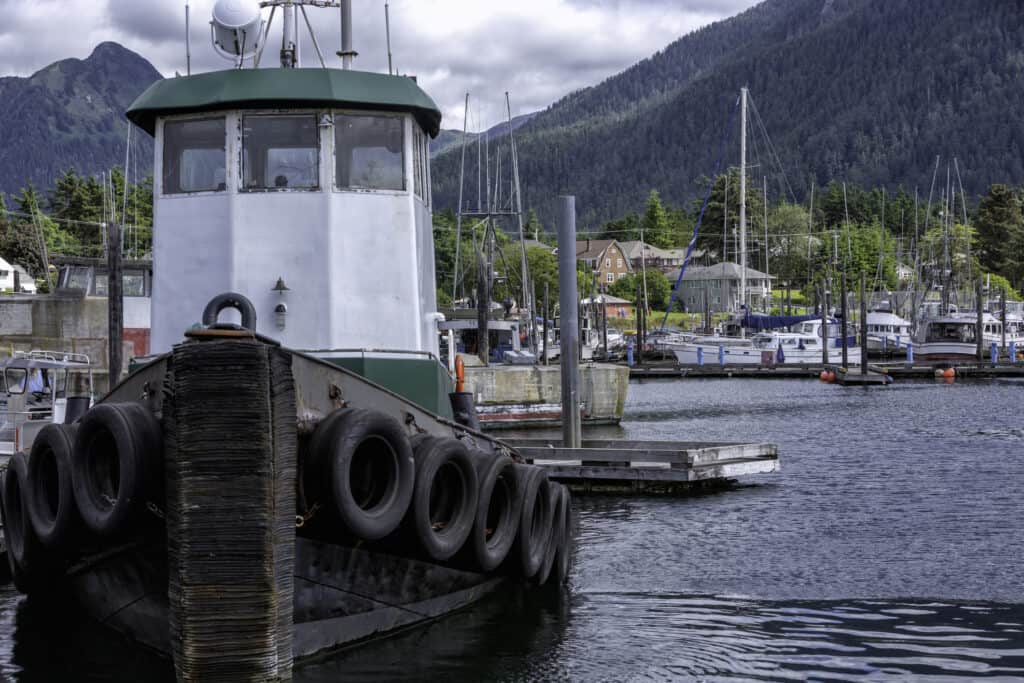
Its position as a coastal town provides reliable access to the Pacific Ocean.
©iStock.com/John McQuiston
We will start our Alaskan exploration with the oldest city in the state, Sitka. When the Russians founded the city in 1799, they made Sitka the capital. Here, the officials sealed the deal with America after the $7.2 million purchase of Alaska. Sitka is a charming coastal town with exquisite historical artifacts from the past Russian occupation.
As the capital of Russian America, Sitka hosted fur traders as a trading post and transit city. Russian colonial footprints are evident throughout the city, including the oldest Russian Orthodox church, St. Michaels Cathedral, built in 1848. Notably, other Russian architectural designed buildings dot the city. Sitka only has a population of 9000 people, making it the fourth-largest city in Alaska.
Sitka is located on Banaof Island, with snow-capped mountains and dense forest forming its captivating landscape. Its position as a coastal town provides reliable access to the Pacific Ocean. This city is home to the largest national forest in the United States, the Tongass National Forest, which surrounds the city.
In 1884, cruise ships started docking at the city, which made it the perfect destination for tourists. The people of Sitka are welcoming and value community. Further, they love the outdoors and have a thriving art scene, with artists drawing inspiration from the city’s stunning landscape. Each year Sitka plays host to the Annual Sitka Summer Music Festival, which attracts musicians from all over the world.
Come rain or shine, Sitka is a city of beauty and adventure. With only 14 miles of roads, it’s easy to explore the mountains, sea, and all that this charming destination has to offer. Showers last for three to five days each time it rains here, so make sure you pack appropriate gear. Enjoy breathtaking views and a friendly atmosphere that will make your visit memorable.
2. Kodiak
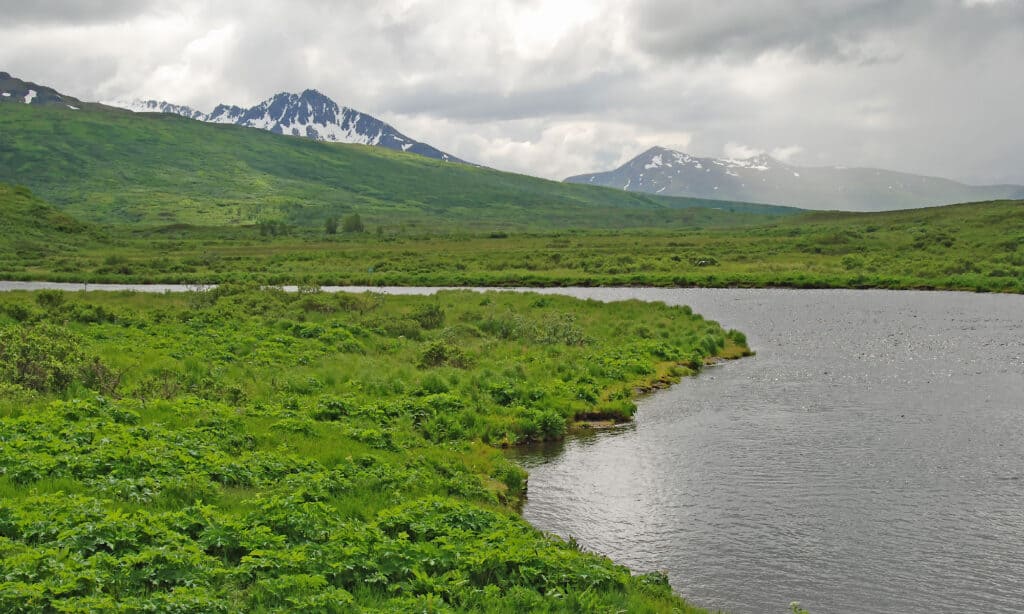
Three cultures, including Native Americans, Russians, and Americans, converge on the island and form the city’s architecture and cuisine.
©iStock.com/Wildnerdpix
Kodiak, formerly known as Pauls’ Harbor, is the second-largest island in the U.S. Russian explorers founded the city as a commercial fur trading port during the 18th century. According to the 2020 census, the city’s population went from 6,130 in 2010 down to 5,581 a decade later. Kodiak is the 10th most prominent city in Alaska.
Three cultures, including Native Americans, Russians, and Americans, converge on the island and form the basis of the city’s architecture, cuisine, and traditions.
The Alutiiq inhabited this region for over 7,500 years, and the city has a museum to celebrate their heritage. The Alutiiq Museum and Archeological Repository Museum showcase the culture and traditions of the Alutiiq people. Tourists visiting the museum can explore the Alutiiq art, music, and oral traditions, along with the impact of colonization and modernization on the community.
Fishing is an economic activity that accounts for a significant portion of local jobs. The commercial fishing industry includes fishing and processing fresh fish, creating an abundant seafood industry, with fresh seafood available at local markets and restaurants.
3. Juneau
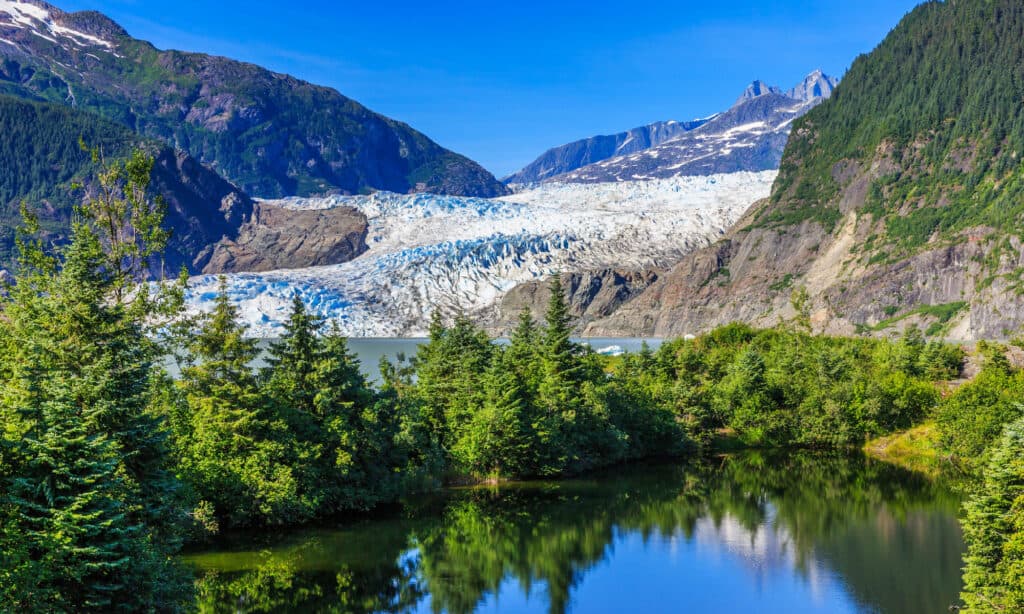
Major economic activities in the area include fishing and tourism. The town has a thriving seafood industry.
©iStock.com/SCStock
Juneau was founded in 1881 by Joseph Juneau and Richard Harris and became the state capital in 1906 after the government was transferred from Sitka. Lying just next to Canada, it is the only state capital in the United States that borders a foreign country. It is also the only state capital that’s inaccessible by road. Visiting state constituents, which play a significant part in the economy, have to use a plane or ferry to visit Juneau.
Tlingit people inhabited this region for over 10,000 years. Since then, the city has undergone many name changes, including Rockwell and Harrisburg.
Major economic activities in the area include fishing and tourism. Salmon and halibut are great catches in Juneau and drive the thriving seafood industry.
Juneau landscapes comprise high mountains and thick forests, with the sea accessible to locals and tourists. Outdoor sports form part of the city’s recreational activities, including hiking, fishing, and kayaking. Juneau is a mix of nature and metropolitan. This means you can enjoy birdwatching or observe bears in their natural habitat alongside a fleet of cruise ships and other big-city amenities.
4. Ketchikan
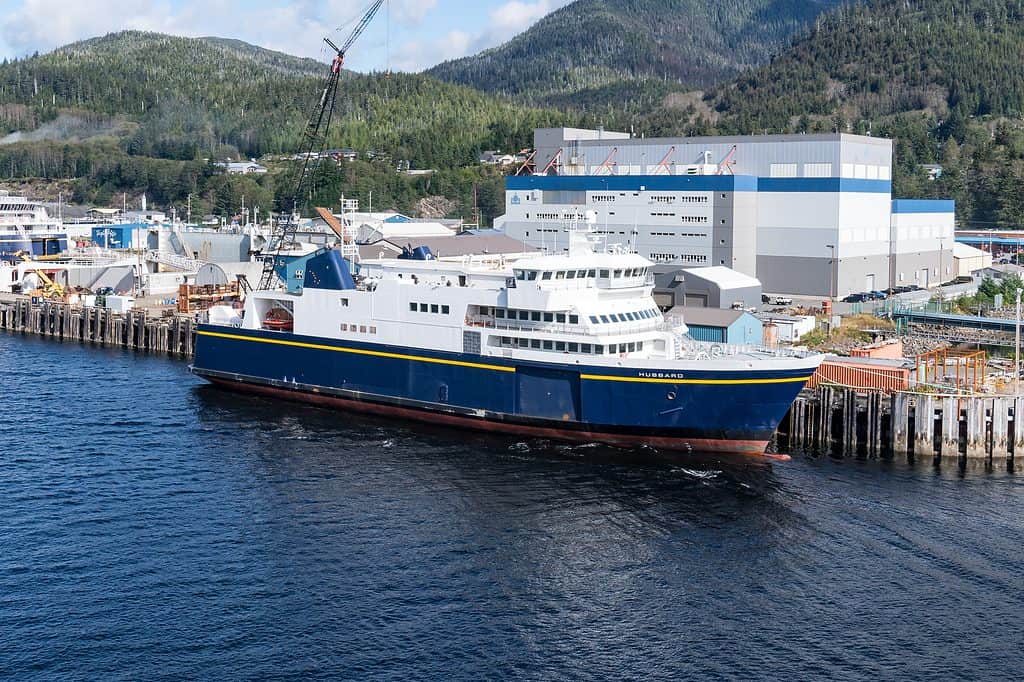
The town of Ketchikan is inaccessible by road, and visitors can only visit the city by air or sea.
©Paul Brady Photography/Shutterstock.com
Ketchikan is dubbed “the first Alaskan city” primarily because of its strategic position at the southern tip of the Inside Passage, which links the Gulf of Alaska to Puget Sound. Visitors will be amazed by the native cultural heritage, idyllic scenery, and ever-so-delicious salmon.
The Tlingit people inhabited the area for thousands of years. In the past, the Inside Passage, a string of waterways that cut through the breathtaking wilderness, gave Ketchikan prominence as a trading post. At the same time, the Native Tlingit traded furs and other items with the Russians and European explorers.
In 1885, Mike Martin established the city, and it became a salmon canning haven. At some point, it was called the “canning salmon capital of the world.” During the same period, logging became part of the economic activities in the region.
Ketchikan is inaccessible by road, and visitors can only visit the city by air or sea. If you are an outdoor fan, you’ll enjoy camping, fishing, and wildlife viewing. Several camping sites include the state’s 18-mile recreation campsite and hiking trails. Downtown Ketchikan hosts cruise ships on its docking harbor. Visitors can enjoy a walk on the historic creek street, a picturesque boardwalk built on stilts over Ketchikan Creek.
5. Wrangell
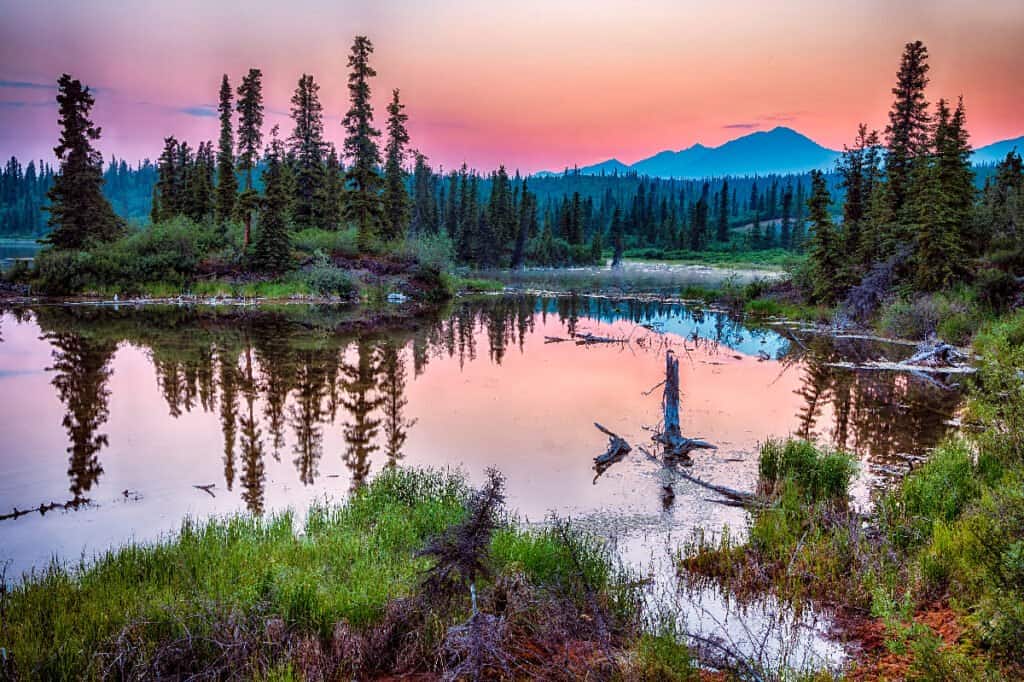
The Stikine River offers excellent wildlife viewing and exploration.
©iStock.com/troutnut
Wrangell is a city of about 2,500 people. It is the entryway to the Stikine River. The city holds a rich and exciting history as one of the oldest cities in Alaska. Wrangell is the only city in Alaska under three flags and was ruled by four nations, including the Tlingit, Russians, Americans, and Indians.
A rich Tlingit culture permeates the region, since these natives have occupied the area for over 10,000 years. Tlingit historical art attracts tourists from all around. Visitors can find a collection of totems scattered throughout the city, including a killer whale totem that adorns Chief Shakes Grave.
The Stikine River offers excellent wildlife viewing and exploration. Visitors can also enjoy fishing, kayaking, or river boating. The region is a terrific place for birdwatching and has hundreds of bird species, including the bald eagle.
6. Petersburg

In mid-May, Petersburg hosts a Norwegian-themed festival which includes a Norwegian Independence Day celebration.
©Tatohra/Shutterstock.com
A Norwegian called Peter Buschmann settled into the area in 1897 and founded the town, which was named Petersburg after him, where he opened a cannery and built a sawmill and docks and the area thrived as a result. He invited his family and friends from back home, and a small community bustling with Norwegian culture formed. Unsurprisingly, the city’s architecture and warmth draw inspiration from Scandinavian culture.
In mid-May, Petersburg hosts a Norwegian-themed festival which includes a Norwegian Independence Day celebration, a parade, dances, and fresh seafood. The city is famous for its public art that depicts its long-held lineage with the Scandinavian countries.
Fishing is part of the Petersburg community, and visitors get an opportunity to fish and learn about the fishing history here.
Icebergs floating near the glacier are a significant attraction in the city, and visitors can view them on day cruises. Tourists also enjoy exploring the Petersburg hiking trails, which are wheelchair accessible. Additionally, visitors can discover breathtaking waterfronts, view wildlife, or go tide pooling in the sandy beach park.
7. Haines
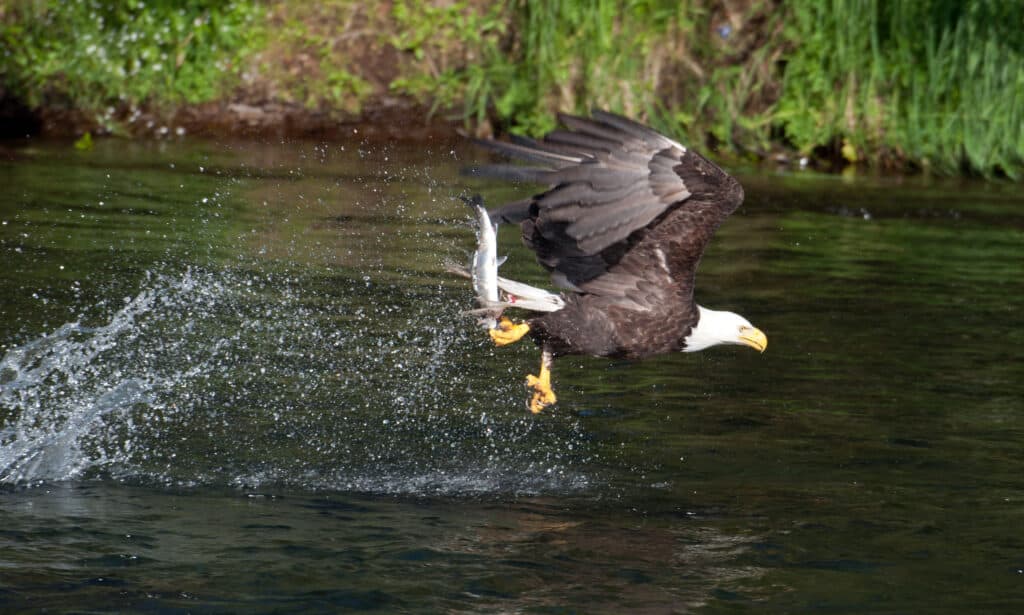
Natural wildlife includes bald eagles, which are great fun to watch. These impressive birds congregate in Haines to feast on the salmon.
©Tony Campbell/Shutterstock.com
Haines native Tlingit name is Deishu, which means “the end of the trail.” The small city is quite significant, as it connects the communities along the Inside Passage to the Alaskan Highway. Travelers pass through Haines on their way to Yukon and the interior of Alaska, and ferries bring RVers traveling to the Alaskan Highway. Even though a lot of vehicle traffic makes its way to the small city, it still retains its small-town charm.
Haines was established alongside Skagway during the Klondike Gold Rush. Jack Dalton found an opportunity to create an existing Tlingit trade route. Later, this route attracted the attention of the U.S. Army, who built a permanent post near the gold mines.
Haines is regarded as one of the sunniest regions within the Inside Passage, with fewer than 2000 people. Its breathtaking beauty captures visitors’ imaginations. Travelers enjoy the native Tlingit art and museums, along with captivating scenic views of the oceans. Additionally, Haines offers the perfect backdrop for hiking, kayaking, camping, or fishing.
Natural wildlife includes bald eagles, which are great fun to watch. These impressive birds congregate in Haines to feast on the salmon, inspiring an annual event: the Alaska Bald Eagle Festival.
8. Skagway
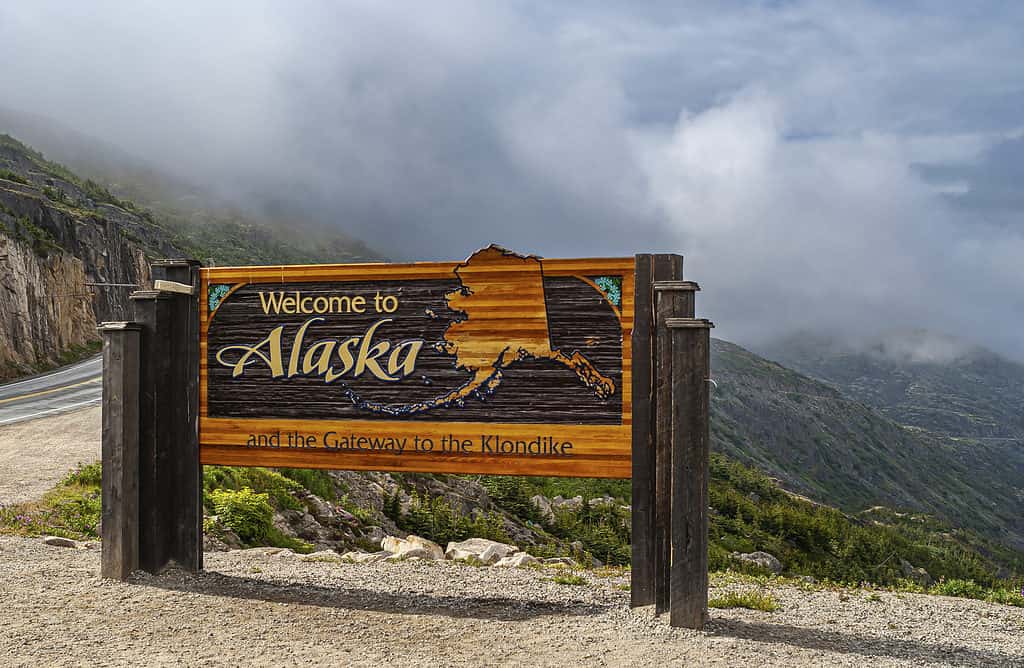
While the population of Skagway is roughly 1,300, the area hosts more than one million visitors each year.
©iStock.com/ClaudineVM
Skagway, just like Haines, was established through the Klondike gold rush. Tens of thousands rushed to the region, hoping to find gold and make it big. The original Tlingit name was Shgagwei, meaning “roughed-up water.” While the population of Skagway is roughly 1,300, the area hosts more than one million visitors each year, partially because it is one of the cities in Alaska accessible by road.
Memories of the gold rush continue to permeate the area. To this day, locals participate in historical reenactments, while dressed in costumes alongside shops, restaurants, and restored buildings. For more than 100 years, visitors have been entertained at “the days of 98 Show.” It is a theatrical showcase that includes mock gambling, poetry, and a showcase of the city’s significant historical events. Additionally, visitors can learn more about the Alaskan native heritage and the gold rush at the Skagway Museum. Dyea, now a ghost town, is also an excellent destination for visitors interested in history.
Visitors can also enjoy the White Pass and Yukon Route Railroad. The narrow-gauge railway was built in 1898. Visitors can choose a full-day trip or a two-hour ride or connect their tours with camping drop-offs or hiking connections. Hiking and backpacking in the mountain are excellent ways to enjoy Skagway’s scenic beauty.
What’s Exciting About The Oldest Cities In Alaska?
Drawing inspiration from the expansive state’s rich history, each city highlighted here is worth visiting. And their history makes these cities terrific destinations for families. Whether traveling on a cruise ship, backpacking through the mountainsides, or RVing in the region, Alaska is a gem for visitors.
Some of the cities pay homage to the Russians, offering a glimpse of U.S.-Russian ties, despite the current strenuous relationship between the two countries.
Many of these Alaskan towns have ports that play into the region’s commercial activities. Further, the ports are used for docking large cruise ships.
The riveting mountainside, dense forests, and inspiring waterways surround these cities. The mountains are perfect for hikers or campers, while the sea and rivers are fantastic for boating and kayaking.
Furthermore, you can learn all about Alaska’s cultural melting pot through the state’s numerous museums.
Summary Of The 8 Oldest Cities In Alaska
| Rank | City | Founded/Established | Incorporated City |
|---|---|---|---|
| 1 | Sitka | 1799 | 1913 |
| 2 | Kodiak | 1792 | 1940 |
| 3 | Juneau | 1881 | 1900 |
| 4 | Ketchikan | 1885 | 1900 |
| 5 | Wrangell | 1834 1839 (British) 1867 (American) | 1903 |
| 6 | Petersburg | 1897 | 1910 |
| 7 | Haines | 1881 | 1910 |
| 8 | Skagway | 1897 | 1900 |
The photo featured at the top of this post is © iStock.com/Nathaniel Gonzales
Thank you for reading! Have some feedback for us? Contact the AZ Animals editorial team.






